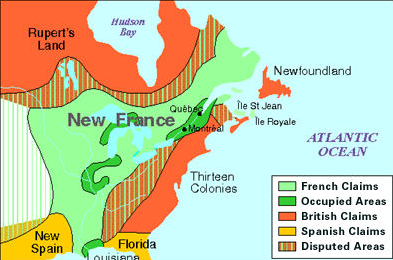What Was The Main Economic Activity In New France – The history of France’s presence as a colonial power in North America extends from the early sixteenth century, at the time of great European discoveries and fishing trips, to the early nineteenth century while Napoleon Bonaparte sells Louisiana to the United States of America.
Table of Contents
New France Map
 New France Map
New France Map
This French adventure in America is marked by important commercial exchanges, but also by recurring conflicts with the native nations established on a vast territory which the French sought to appropriate. This business is also motivated by religious objectives and the desire to establish a settlement on the shores of the St. Lawrence.
Aboriginal peoples have lived for millennia on the territory that becomes New France and the Vikings frequent it from the end of the tenth century (see Vikings Expedition). However, it was mainly from the founding of Quebec in 1608 until the cession of Canada to England in 1763 that France permeated the history of a continent from which it came to control three-quarters of the land, including the Acadia. It establishes, particularly in the St. Lawrence Valley (see St. Lawrence Lowlands) a population that is able to affirm its vitality and culture to this day.
Foundation and context Of New France
Where was new France – In the sixteenth century, the founding of New France was part of the vast movement of great discoveries. Following the other powers of the Christian West (England, Spain, and Portugal) and businesses of Christopher Columbus in 1492, John Cabot in 1497, and brothers Corte-Real (see also Portuguese), France is interested in new lands. In 1524, Giovanni Verrazzano runs along the eastern coast of America, from Florida to Newfoundland. Later, Jacques Cartier makes three voyages of discovery. He took possession of the territory in the name of the King of France by planting a cross in Gaspé (see Gaspésie) in 1534. The following year, he goes up the St. Lawrence, winters in Stadacona (site of the present city of Quebec), and goes to Hochelaga (Montreal). During the winter, twenty-five of his men die of scurvy. In 1536, he returned to France.
In 1540-1541, Cartier returned and attempted to establish a colony at the mouth of the Cap-Rouge River. If religious objectives have guided the organization of these trips, the economic motives are even more obvious. The hope of finding a route to the Indies is constantly asserted (see Northwest Passage).
In 1534, the king asked Cartier to “discover certain islands and countries: it is believed that there must be a large amount of gold and other wealth.” On his last trip, the discoverer brings back minerals he believes to be gold and diamonds. It was only iron and quartz (see Diamonds of Canada). France then lost interest in this distant country until the end of the century.

New France Map
What Was The Main Economic Activity In New France
Which economic activity was common in new France – For an overseas colony to survive, it is necessary to encourage the creation of businesses on the spot, exploit its natural wealth, and ensure the production of essential goods.
Fishing establishment, Baie de Plaisance, around 1700, Gerard van Edema
This section discusses the beginnings of trade during the era of French colonization in North America. It recalls that whaling and cod, a seasonal activity, has led to the establishment of the first French on the continent. Admittedly, this activity will only occupy a small part of the population, but it will nonetheless remain an important component of the economy throughout the French Regime, and even beyond.
However, IN REAL, Which Economic Activity Was common in New France
The most important economic activity in new France was The fur trade as it was the real economic engine of New France. The exploitation of furs, which has ensured the wealth of Canadians, is largely what has favored the exploration of the continent. In addition, trafficking has created alliances with many indigenous peoples.
Finally, even though France’s mercantilist policy prohibited the creation of companies likely to rival those of the metropolis, a variety of initiatives gave birth to a craft and industrial sector.